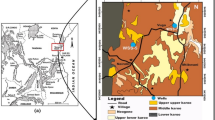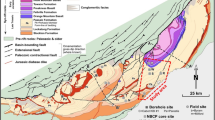Abstract
The probability of occurrence of natural resources, such as petroleum deposits, can be assessed by a combination of multivariate statistical and geostatistical techniques. The area of study is partitioned into regions that are as homogeneous as possible internally while simultaneously as distinct as possible. Fisher's discriminant criterion is used to select geological variables that best distinguish productive from nonproductive localities, based on a sample of previously drilled exploratory wells. On the basis of these geological variables, each wildcat well is assigned to the production class (dry or producer in the two-class case) for which the Mahalanobis' distance from the observation to the class centroid is a minimum. Universal kriging is used to interpolate values of the Mahalanobis' distances to all locations not yet drilled. The probability that an undrilled locality belongs to the productive class can be found, using the kriging estimation variances to assess the probability of misclassification. Finally, Bayes' relationship can be used to determine the probability that an undrilled location will be a discovery, regardless of the production class in which it is placed. The method is illustrated with a study of oil prospects in the Lansing/Kansas City interval of western Kansas, using geological variables derived from well logs.
Similar content being viewed by others
References
Agterberg, F., 1989, Computer programs for mineral exploration: Science, v. 245, p. 76–81.
Fisher, R.A., 1936, The use of multiple measurements in taxonomic problems: Annals of Eugenics, no. 67, p. 179–188.
Harff, J., and Davis, J.C., 1990, Regionalization in geology by multivariate classification: Mathematical Geology, v. 22, p. 573–588.
Hohn, M.E., 1988, Geostatistics and petroleum geology: New York, Van Nostrand Reinhold, 264 p.
Journel, A.G., 1986, Geostatistics—Models and tools for the earth sciences: Mathematical Geology, v. 18, p. 119–140.
Journel, A.G., and Huijbregts, C.J., 1978, Mining geostatistics: London, Academic, 600 p.
Matheron, G., 1970, La théorie des variables régionalisées, et ses applications: Les Cahiers du Centre de Morphologie Mathématique de Fontainebleau, Fascicule 5, Ecole Nationale Supérieure des Mines, Paris, 211 p.
Myers, D.E., 1982, Matrix formulation of co-kriging: Mathematical Geology, v. 14, p. 249–257.
Rodionov, D., 1981, Statisticeskic Resenija v Geologii: Moscow, Izd. “Nedra,” 231 p.
Tatsuoka, M.M., 1971, Multivariate analysis—Techniques for educational and psychological research: New York, Wiley, 310 p.
Watney, W.L., 1984, Recognition of favorable reservoir trends in Upper Pennsylvanian cyclic carbonates in western Kansas,in Hyne, N.J., ed., Limestones of the mid-continent: Tulsa Geological Society, Special Publication No. 2, p. 201–246.
Watney, W.L., Harff, J., Davis, J.C., Bohling, G., and Wong, J.C., in press, Controls on petroleum accumulation in Upper Pennsylvanian cyclic shelf carbonates in Western Kansas, USA, interpreted by space modeling and multivariate techniques,in Harff, J., and Merriam, D.F., eds., Computerized basin analysis: New York, Plenum.
Author information
Authors and Affiliations
Rights and permissions
About this article
Cite this article
Harff, J., Davis, J.C. & Olea, R.A. Quantitative assessment of mineral resources with an application to petroleum geology. Nat Resour Res 1, 74–84 (1992). https://doi.org/10.1007/BF01782114
Received:
Accepted:
Issue Date:
DOI: https://doi.org/10.1007/BF01782114




